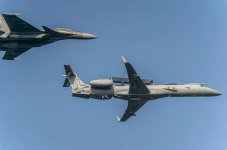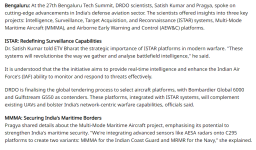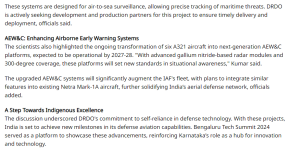The Indian Air Force (IAF), which is short of Airborne Early Warning and Control (AEW&C) aircraft, a critical force multiplier, is looking at the procurement of 12 aircraft under two different programmes.
One of them is a follow-on order of six AEW&C systems mounted on Embraer aircraft, akin to the three Netra systems in service. The other order pertains to six AEW&C systems under development by the Defence Research and Development Organisation (DRDO) that would be mounted on Airbus A-321 aircraft.
“We have three of them, the Embraer based AEW&C. We have plan for six more. We are calling them Mk1A, with minor modifications to the equipment that is inside. [The] idea is to buy the aircraft from Embraer, and being modified by DRDO, Centre for Air Borne Systems (CABS) will be doing the modifications. It is a proven design with minimum risk involved and maximum output,” Air Chief Marshal A. P. Singh said last week. “We should be having it cleared by Defence Acquisition Council very soon.”
The Air Chief said the other development relates to the AEW&C-Mk2, with an Airbus-based system, for which contract negotiations were currently ongoing. “Modification of aircraft is by Airbus, equipment is being developed by DRDO. Initial contract is to be signed with Airbus by DRDO...negotiations are on to come to the correct configurations, as well the price negotiations,” he added.
Six Airbus A-321 passenger aircraft with Air India were transferred to the IAF sometime ago and are awaiting modifications to be undertaken, pending the conclusion of the contract.
Defence officials said that the
modifications required for the aircraft turned out to be significantly more extensive and complex than anticipated, and thus the negotiations over the cost too have dragged on, and the process has been delayed. One official involved in the project said the AEW&C mounted on the Airbus aircraft would provide
300-degree coverage.
The IAF also operates three Israeli Phalcon Airborne Warning and Control Systems (AWACS) in addition to the Netra AEW&C systems. While the Phalcons, which have a radome mounted on top of an IL-76 transport aircraft, provide 360-degree coverage, the Netra provides 240-degree coverage of airspace.
A shortage of these force multipliers was felt during the aerial engagement with the Pakistan Air Force a day after the Balakot air strike in February 2019. A long-pending proposal to procure two additional Israeli Phalcons has not materialised.
In July, the IAF issued a ‘Request For Information’ for the procurement of six AEW&C along with the associated ground segment from registered Indian vendors. According to the requirements, the primary radar should be a multimode/multifunctional solid state 4D AESA (Active Electronically Scanner Array) radar incorporating 360-degree coverage with range not less than 400 km, and be able to detect airborne targets flying as low as 30 metres from the ground to as high as 20 km.
The platform requirement is for a customised jet aircraft configured with payloads/systems of AEW&C and on-board workstations, have endurance of eight hours and above, with an operational altitude of 40,000 feet and above, and also featuring air-to-air refuelling and fuel dumping capability.














